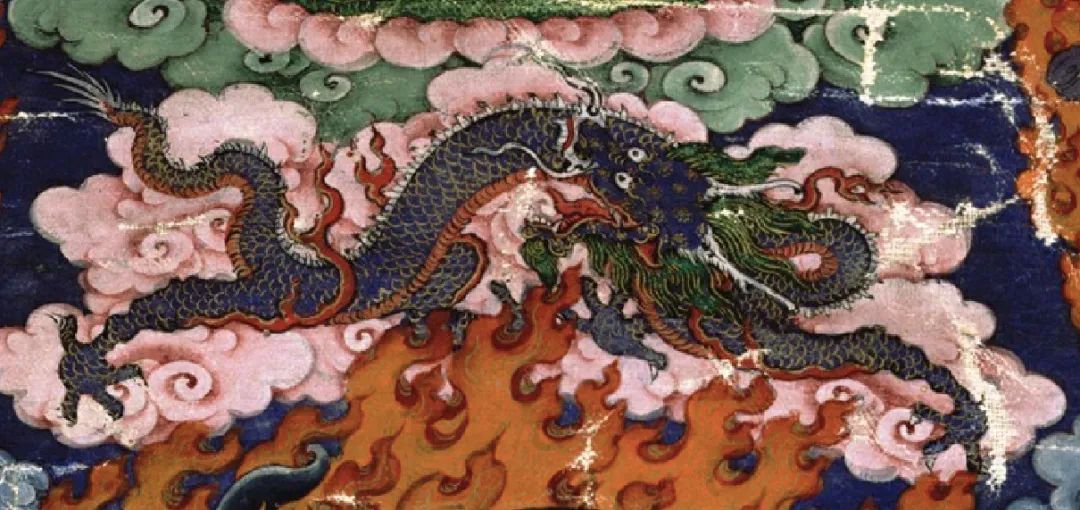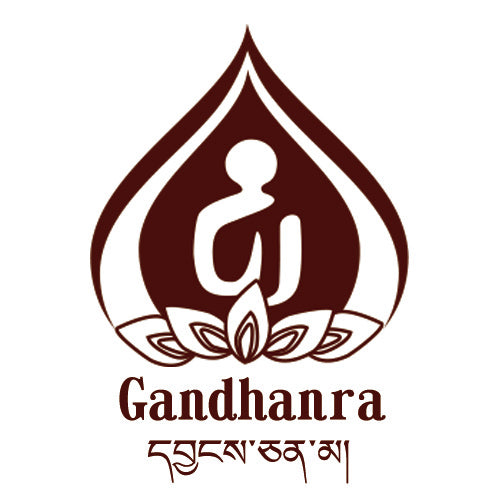
Statement on the Tibetan Dragon

"Carved Dragon Wooden Sign Component"
From the mid-16th century, stored in the Metropolitan Museum of Art
Statement
བོད་འདིར་རྩིས་ལུགས་ལ་བྱེ་བྲག་ཕྱེ་ན་གཉིས་ཏེ། ཕུག་པ་ལྷུན་གྲུབ་རྒྱ་མཚོའི་དང་མཚུར་ཕུ་དོན་གྲུབ་འོད་ཟེར་གྱིའོ། །སྔ་མ་ལྟར་ན་ད་ལོའི་ལོ་གསར་གྱི་ཉི་ཤུ་དགུ་ཆད་པ་དང་། ཕྱི་མ་ལྟར་ན་ཚེས་སུམ་ཅུ་ཆད་པས་དགུ་སུམ་ཉིན་གཅིག་ཏུ་བྱེད་དགོས། ཁྱད་པར་དུ་སྲོལ་རྒྱུན་རྩིས་ལུགས་སུ"ལྷག་ན་སྔ་མ་དང་། ཆད་ན་ཕྱི་མ"ཞེས་གསུངས་པ་ལྟར། ད་ལོའི་ཉི་ཤུ་དགུ་དང་གནམ་གང་གཉིས་ངེས་པར་ཉིན་གཅིག་ལ་ཡིན་དགོས། ད་ལྟ་སྤྱི་ཚོགས་སྟེང་ཉི་ཤུ་དགུ་ཆད་པ་དེས། དགུ་ཐུག་ག་དུས་འཐུང་མིན་གྱི་རྩོད་གླེང་ཞིག་ཐོན་བཞིན་ཡོད་པས་འདིར་ང་ཚོས་ལུང་རིགས་དང་མཐུན་པའི་བདེན་དཔང་བཀོད་པ་ཡིན་ལ། སྒེར་གྱི་སྣང་བ་གདོང་འདེད་ཀྱི་བགྱི་བ་གལ་དུ་ཆེ་མོད་ཀྱི། འོན་ཀྱང་སྲོལ་རྒྱུན་རིག་གནས་ཀྱི་ལུགས་སྲོལ་ཉམས་ན་དེ་བས་ཀྱང་ཉེན་ཁ་ཆེས་ཆེ། །
The Phugpa (ཕུག་ལུགས་) and Tsukpa (མཚུར་ལུགས་) are the two major traditional calendrical systems in Tibetan culture. This year, the Phugpa calendar has a missing 29th day (traditionally a day to offer prayers), while the Tsukpa calendar has a missing 30th day, resulting in the 29th and 30th day being combined into one day, known as "Nine-Three Combined" (དགུ་སུམ་ཉིན་གཅིག་). According to the basic principles of traditional calendrical studies, "missing days should be compensated for before the actual day." Therefore, this year's 29th and 30th day should be considered as the same day.
There is currently a debate in society regarding the timing of the traditional "29th day prayers," and we would like to clarify our stance on this issue. While individual choices should be respected, we believe that cultural facts should not be ignored. Our public platform is dedicated to promoting general knowledge and in-depth research on Tibetan culture, and we feel a sense of responsibility to address this debate and express our position.


"The Calculation Chart: Gods and Goddesses in the Three Realms of the Universe"
Mid-19th Century, Collection of the Rubin Museum
Detail: Symbol of Prosperous and Auspicious Direction in the Lunda System - Jade Dragon
*Translating Longda as "wind horse" is not the correct approach.

Detail: The dragon and tiger symbolize natural auspiciousness and seasonal auspiciousness.
"The dragon brings harmony to the changing elements of all rivers, lakes, and seas."
དཔའ་ལ་བཙུན་པ་སེང་སྟག་གྲུས་མ་དང་འདྲ་བ་ཅིག་ཡིན།
འཇིགས་ལ་ངར་ཆེ་བ་ནམ་མཁའི་གཡུ་འབྲུག་དང་འདྲ་བ་ཆིག་ཡིན།
Brave and noble, like a lioness and a tigress
Terrifying and powerful, like a jade dragon of the sky
*This metaphor is commonly seen in the promotion of familial authority and political status.
རྒྱ་བཟའ་རྒྱ་ཡེ་རྟེན་མཆོག་ཐབས་ཀྱི་དྲངས།
ཡ་མཚན་བུད་མེད་གསུམ་གྱི་བཀྲ་ཤིས་ཤོག།
Princess Wen Cheng plans to take a Han dynasty statue
Princess Hong Zun's friend presents a statue from Nepal
The queen's pearl eyes resemble the dragon in epic tales
May these three wonderful women bring good fortune.
*The queen of King Gesar, Princess Zhu Mu (her name originally means Mother Dragon)
The renowned scholar Zhamtsar Namgyal Tsöndrü (12th to 13th century) of the Sakya school once rode a dragon from Mount Kailash to Kinnara (ཀུ་ནུ་ in Tibetan). In the biographical texts of the Sakya school in later generations, the dragon that the scholar rode had different colors on its way to Kinnara and back to Mount Kailash: it was a golden dragon (གསེར་འབྲུག་) when flying to Kinnara, and a jade dragon (གཡུ་འབྲུག་) when returning to Mount Kailash. Why the color difference? Another scholar, Yongsar Yeshé Gyalsen (1713-1793) of the Gelugpa school in the 18th century, mentioned in a ritual text about Arhats that dragons from South Asia and East Asia are called golden dragons, while local dragons in Tibet are called jade dragons. The Arhats ride golden dragons from Pure Land to Tibet, and later ride golden dragons from Tibet to China to spread the dharma. In essence, such variations in naming reflect the cultural origins of dragons in Tibet: the indigenous dragon culture as well as dragon cultures from other regions.
Nowadays, people often have confusion with the following concepts, which has caused difficulties in understanding the dragon culture in Tibet to a large extent. Firstly, there is the confusion between the "lu" (ཀླུ་) in the native Tibetan belief system, which represents the spirits of the land and water bodies, and the Nagas (नाग) derived from the South Asian "serpent worship" (often translated as dragon race in Chinese). The "lu", represented by snakes, turtles, and fish, are non-human spiritual beings that guard the earth, rivers, and treasures, and have their own social relationships, especially in regard to cleanliness in Tibetan culture. With the introduction of Buddhism into Tibet, the meanings of the South Asian Nagas and the Tibetan "lu" have overlapped in a systematic way. Secondly, there is confusion between the Chinese dragon and the dragon race in Chinese Buddhism. Similar to the previous example, this is also a result of the localization of foreign concepts, where the dragon race originally did not refer to the creature dragon.
Next is the "Lu" of the Tibetan area and the Tibetan dragon (འབྲུག་; transliterated as Zhu). People cannot use the dragon to summarize "Lu", as the dragon is not a core member in the "Lu" system. In some Bon literature, the ascending "Lu" may become a dragon, while early descriptions of the dragon focus more on two points: the symbol of storm clouds (a gathering) and a kind of wriggling creature (etymology analysis). Finally, there are the dragons of the Tibetan area and the Han area, and their iconographic characteristics tend to be similar nowadays, but their meanings in their respective cultures are different.

"The Saga of Benjiao War Spirit, Benefactor Xijia Bo and His Retinue"
Mid-19th century, collection of the Ruben Museum
Detail: The Puhua Great Dragon, riding a dragon, holding a spear and flag
(Chief of the Southern Dragon Clan of Sovereign Power)

"Four Seasons, Four Beasts, Four Women"
20th century, in the collection of the Rubin Museum
Detail: Summer woman riding a green dragon, Autumn woman riding a snow lion
(Four beasts, four women, forever blessing the four seasons on Earth)
" སེང་འབྲུག " (Lion Dragon) is also a classic concept combination

From 'Cultural Relics of Tibet: Central Region'
Written by the Tibetan historian and scholar, Venerable Bawo Zunzhe."
(དཔའ་བོ་གཙུག་ལག་ཕྲེང་བ་;1504-1566)
It can be known that dragons are considered as members of the "Lu" ethnic group.
In early texts such as the "Five Lost Teachings" and "The Biography of Guru Rinpoche," the generation of thunder is believed to be the product of the interaction of various elements within cloud formations, while the thunderous sound that resounds through the sky is associated with mythical creatures within the clouds. Dragons are praised as the "celestial elephants" (ནམ་མཁའི་གླང་པོ་; also a title for clouds) and the "celestial drums" (ནམ་མཁའི་རྔ་ཆེན་), with the sound emanating from their mouths symbolically marked in Tibetan texts as ཨུན་ (a low humming sound). This sound, though not clear, is considered pleasant to the ears; therefore, the dragon's roar and the buzzing sound of bees (a higher-pitched hum) are deemed as auspicious signs of abundant agricultural and pastoral harvests and good fortune.

"Garma Garsha School of Sixteen Elders: Janno Jafaxa Caxa"
Late 18th century, from the Rubin Museum
Detail: Jade Dragon holding a vase symbolizing the power of wind and clouds
Later Buddhist scholars even likened the roar of the dragon to the sound of Vajra touching the ground and the sound offering given to the accomplished ones in the heavenly realms. Many monasteries in today's Tibetan regions still retain sacred items related to dragons, such as dragon whiskers and dragon bones (a high-quality painting pigment), and the place where a dragon dies is also considered an excellent site for building palaces and fortresses. However, dragons can be good or bad; evil dragons devour the sun, moon, and rivers, causing diseases, while good dragons serve as attendants to Buddhas, Bodhisattvas, and spiritual teachers. In popular folk stories in the Mutsang region, there was once a fierce battle between evil dragons, such as black and red dragons, and good dragons, such as golden and jade dragons.
Nowadays, people refer to the dragon and phoenix originated from Han region as "བྱ་འབྲུག་" (bird + dragon); however, in the local traditions of Tibet, this term points to the jade dragon and the great roc bird (or the local qiong bird; ཁྱུང་), with the jade dragon being the core concept of Tibetan dragon culture. The dragon, shining in emerald jade color, gallops between the world, and the monarchs and illustrious families on earth use it as a symbol of their power and authority. "The king's governance and demeanor are like the elephant and the jade dragon," and wearing turquoise is like being enveloped by a jade dragon.

"The Creation Elements of Only Gods and the Ben Religion"
19th century, collection of the Rubin Museum
Detail: Roc (Phoenix) and auspicious dragon
It should be noted that the term "jade dragon" in Tibetan originally meant "a turquoise-colored dragon", as turquoise is seen as a symbol of soul and wealth in Tibetan culture. In various legal documents and government notices, "jade dragon" is used as a synonym for "worldly power". With the later introduction of Han Chinese imperial ideology, the meaning associated with the local dragon was strengthened. Dragons have a distinction between male and female, and if the connotation of the male dragon is related to a political culture centered on male dominance, then the female dragon is associated with life studies and protective forces, as exemplified by the feminine jade dragon of the Thirteen Warrior Spirits (དགྲ་བླ་གཡུ་འབྲུག་སྔོན་མོ་).

"Blue Lapis Lazuli Tibetan Medicine Thangka: Medical Advice"
In the first half of the 20th century, the Tibetan medical hospital in Lhasa
Local: There are one hundred and one kinds of deadly diseases, like a dragon devouring the sun and moon.

"The Traditional Five-Directional White Haer Wang with Hidden Treasures"
From the 19th century, housed in the Rubin Museum
Detail: The auspicious dragon in the pink cloud cluster

May the Dragon bless you with prosperity and courage.

